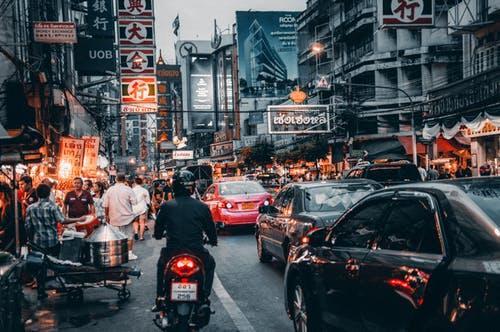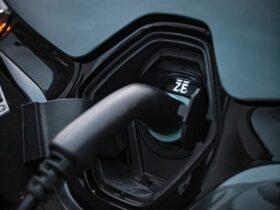As cities around the world move toward greater mobility, different transportation modes are being introduced, offering commuters more options to help get them to where they need to be. One such mode that has rapidly gained popularity around the globe in recent years is the electric scooter (e-scooter), often in the form of scooter-sharing startups. The trend is generating plenty of buzz, as well as concern.
Recently, scooter-sharing systems have been introduced in some parts of Thailand. Wander around Thong Lor and Ekamai today, and you’ll see orange e-scooters outside BTS stations and in front of cafes and restaurants. Increasingly, someone on a scooter will cruise past you on the pavement.
Neuron, a scooter-sharing company based in Singapore, introduced its line of orange e-scooters in Chiang Mai late last year.
The company expanded its service to Thammasat University (Rangsit campus) in January, before coming to Bangkok in May. In the capital, the service area started out in Thong Lor before expanding from Asok to On Nut BTS stations, and Phetchaburi to Queen Sirikit National Convention Centre MRT stations. Collectively called the Thong Lor zone, Neuron provides around 200 e-scooters in this area. It is reported that users take approximately 500-600 trips daily within the zone.
The service comes with an app, and geo-fence and GPS tracking in each dockless scooter. Designated parking spots can be located using the in-app map. Neuron also employs staff to go around the area collecting scooters, replacing batteries and ensuring abandoned scooters don’t end up dumped together in ugly clutters.
“It’s not about simply buying scooters and placing them on the street. We look at it in terms of city planning too, as well as incorporating technology to keep things safe while helping with the smart city initiative,” said Nate Chanchareon, Neuron Mobility’s head of business development.
To avail of the service, users have to download the app and scan a QR code on the scooter. Then they just hop on and ride. The pay-per-ride rates start from 20 baht, with an additional 1 baht per minute. Daily, weekly and monthly rates are available. The scooters can reach speeds of 20-25km/h. Basic insurance is provided, helmets are not.
Nate said feedback from commuters has been positive. In Chiang Mai, many use it for tourism and leisure purposes. Within the university campus, students ride scooters from dorm to class, as well as for recreation. In Bangkok, the scooters are mainly being used for commuting purposes, connecting from the BTS/MRT to the home or workplace, providing a solution to the first-mile/last-mile (FMLM) connection problem, an attractive alternative to motorcycle taxis, taxis or walking.
“Consider any given Friday. The traffic is heavy.
Some people may not want to ride on a motorcycle. Scooters can then be a faster option than cars and cheaper than a taxi for the first-mile/last-mile connection. They’re suitable for commuting short distances. The more options there are, the better they help ease the traffic,” said Nate. As they run on electricity, the scooters are also more eco-friendly.
Outside of Thailand, Neuron also provides scooter-sharing services in Singapore and Cyberjaya in Malaysia, and will be heading to Brisbane and Darwin in Australia soon.
Globally, scooter-sharing services have experienced strong growth since 2017, starting in Europe before making their way to the US and now Asia. However, despite the benefits, there are concerns over safety. According to Nate, some minor injuries have been reported from people falling over while using the scooters. There still is risk, of course, which Nate describes as “similar to riding a bicycle”.
Everywhere reacts to the arrival of e-scooters differently. For example, the Queensland authority issued regulations on helmets and speed limits. Riders can use footpaths only, not bike lanes or roads. In some locations, such regulations are not enough, with people seeking to ban the scooters altogether.
In Thailand, scooter-sharing is still in its infancy. While its usage is steadily growing, there are as yet no clear regulations in place. Assoc Prof Pawinee Iamtrakul, from the Faculty of Architecture and Planning at Thammasat University, says the use of scooters can be safe as long as regulations are in place.
“In a closed area like a university campus, which you don’t need to share with other vehicles, it’s quite safe to use scooters. But in other areas, it could be dangerous,” she said. “The state is the best entity to decide which zones could be used for sharing. They know what should and shouldn’t be allowed. In the end, we don’t want anyone to be in danger.”
This goes both ways. Users have to be educated on how to safely operate the scooters, and on which areas are safe to travel in. This will make it easier for the state to step in and impose appropriate regulations ensuring minimal disruption and maximum safety.
In Bangkok, authorities have been redoubling their efforts to clear the pavements for pedestrians by banning motorcycles and vendor carts. Is it ideal to throw scooters into the mix? Plus the precarious state of the city’s footpaths, already broken up and uneven, create difficulties for pedestrians. Surely scooters are not well suited to such terrain.
Pawinee believes it’s up to different sectors to come together and manage the sharing of space. If sections of footpaths can be cleared and then properly designated as areas for scooters and other mobility devices, she says, it could be beneficial to all, including pedestrians, senior citizens and people with disabilities.
“People have different limitations. Scooters are one option that can help them travel longer distances. It’ll be helpful to improve basic infrastructure to accommodate a diversity of users for greater connectivity, accessibility and safety,” she said.
Additionally, she argues, e-scooters can be used to promote tourism and help local economies.
Despite the controversies and uncertainties that surround scooter-sharing, both Nate and Pawinee are confident that they have the potential to grow.
“As long as Thailand continues to have road traffic problems, people will seek alternatives,” said Nate. “If there’s a more reliable, faster, maybe even cheaper option, people will use it. In Bangkok, the infrastructure isn’t bad in all areas. There are places that may be good for using scooters.
However, he pointed out, the pavements and bike lanes must be improved, and clear regulations put in place.
“It’s not just about business but also community,” he says. “We can strive for sustainable goals and be environmentally friendly. So, if more people learn to accommodate the scooters, it should help make Thailand more liveable. With safety concerns, we can put them on the table: let’s see what the problems are and try to solve them.
“Bangkok already has an established transit backbone in the shape of the MRT and BTS. The next thing to do is address first-mile/last-mile connections; improve them by providing more options, be they bicycles, scooters or something else. Set up designated lanes and make them safe. If we can do this, I think people would rely less on personal cars.”
Pawinee also underlined the importance of connectivity between small, medium and large transit modes. These should be designed to feed into each other seamlessly for added convenience and safety.
“Today, many people feel that using their own car is more convenient than using public transportation … With new options and development, they should be able to create a better society, beyond just commuting,” she said.
BANGKOK TEST RIDE
It was pretty scary trying an e-scooter for the first time in Bangkok. The sight of uneven pavements, random manholes, pedestrians, vendor carts, trees, utility poles, motorcycles and everything else that clutter the city’s sidewalks and sois suggested an unpleasant ride. But to my surprise, the experience was much more pleasant than I’d anticipated.
I recently dropped by BTS Phrom Phong station to give the scooters a shot. My destination was Donki Mall, Thong Lor 10. As I’d already downloaded the application and linked my credit card, I was ready to go. A Neuron staff member who was checking on the scooters outside the station, gave me some basic instructions on how to operate the scooter and use the app.
Then I was off. Even for a first-timer, the scooter was easy to ride. The real challenge was to avoid all of obstacles and get to my destination in one piece. Sure enough, it proved to be difficult terrain. I spent half the time riding and the other half pulling and lifting the heavy scooter. I was drenched with sweat by the time I got to my destination, almost half an hour later, a distance of 3.4km. I paid 45 baht. Comparatively, the same trip using the Grab motorcycle taxi service is 48 baht and over 75 baht for a Grab taxi.
It was quite a tiring ride. But on the occasions when the pavement was long and obstacle-free, it was actually pretty fun zipping along on the scooter. The potential of this transportation mode is quite clear. I can see it becoming a practical and convenient option in places with better infrastructure and terrain. In Bangkok, it’s really crucial to take precautions and watch where we’re going. Another added plus is that I passed by some interesting local shops that I never really noticed when driving a car.















